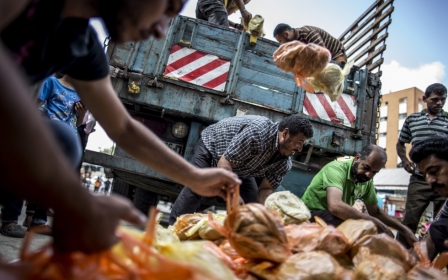Gandhian struggle was never an option for Gaza

“Where is the Palestinian Gandhi? In Israeli prison, of course!” was the title of an article by Jo Ehrlich published in Mondoweiss.net on Dec 21, 2009. It was written almost exactly one year after Israel concluded a major war against Gaza, Operation Cast Lead (December 27, 2008 – January 18, 2009) which was until now the deadliest Israeli attack against the strip for many years.
Ehrlich was belittling the question of a ‘Palestinian Gandhi’, while responding to the patronising approach others had taken to the concept: “Not that I’m in any way playing into the Palestinian Gandhi dialogue, I think it’s actually pretty diversionary/racist. But sometimes you have to laugh in order not to cry...”, he writes in his opening paragraph.
Indeed, the concept of a “Palestinian Gandhi” was and remains ignorant, patronizing and racist. But the question is also inescapable, especially for people who classify themselves as “pro-Palestinian activists”.
Israel’s latest war – Operation Protective Edge – has surpassed Cast Lead in terms of duration, casualities, level of destruction - and the sheer horror of targeting civilians – and still the Gandhi question seems more muted than usual.
To understand why, one needs to first examine the reason why demands were made on the Palestinians to produce a non-violent Gandhi alternative in their struggle for freedom in the first place.
The Second Palestinian Intifada (uprising) from 2000-2005 illicited an extremely violent Israeli response. Israeli leaders at the time meant to send a message to the then Palestinian leader, Yasser Arafat, that they had no patience for any act of collective defiance. Israel was convinced that Arafat engineered the Intifada to strengthen his political position in “peace talks” which proved to be worthless.
Caught in an impossible situation that included facing a US-fed Israeli war machine - and having no faith in their leadership - Palestinians resorted to arms, using suicide bombings as well as other violent methods.
The tactic raised much controversy – due to the death toll among Israeli civilians – and was quickly used in Israel-Western propaganda to retrospectively explain Israel’s military occupation and justify its harsh military tactics.
Those who dared explain Palestinian violence within its proper context, or who underscored that many more Palestinian civilians were still being killed by the Israeli army, were shunned by the media, and at times seen as a liability by those who kept on classifying Palestinians as victims.
Many Westerners (from presidents, to philosophers, to journalists, to social media activists) deliberated the matter with enthusiasm. The fact that few Western countries have truly experienced an anti-colonial national liberation struggle in their modern history, and thus lack any real understanding of the humiliation and anger experienced by these nations, seemed to matter little. Some were simply concerned about Israel and no-one else. Others wanted to preserve the image of the Palestinian as an occupied, hapless, eternal victim.
The most egregious presentation of this language was made by then-newly elected US President Barack Obama, who stood at a Cairo university podium on June 4, 2009, to convey to Palestinians a denigrating, insensitive and highly inaccurate message:
“Palestinians must abandon violence. Resistance through violence and killing is wrong and it does not succeed. For centuries, black people in America suffered the lash of the whip as slaves and the humiliation of segregation. …
But it was not violence that won full and equal rights. This same story can be told by people from South Africa to South Asia; from Eastern Europe to Indonesia. It's a story with a simple truth: that violence is a dead end.”
Obama’s message painted the Palestinian struggle as an abnormality among perfectly peaceful national liberation struggles around the world. This message was of course untrue.
The US president either didn’t know or wished to ignore a Palestinian history of non-violent resistance that goes back to the 1920s and 1930s - and arguably earlier than that.
Obama, like many others, fails to appreciate how much extreme Israeli violence, using weapons that the US has continued to supply to Tel Aviv, has factored in subduing Palestinian resistance. Washington’s weapons have also helped Israel to maintain a relatively easy military occupation and to keep Jewish settlements thriving on stolen Palestinian land.
But the decisive point in the discussion was the Second Intifada, which incited much Israeli violence, resulting in the death of thousands. The political implications of the uprising were also quite significant as it divided Palestinians between those who were intimidated by the Israeli tactics into submission (the so-called moderates), and others who seemed unrepentant (the so-called radicals).
For nearly 10 years now, the debate has raged. Some condemned Palestinian armed resistance outright, others offered mutual criticism of Israeli and Hamas violence, while another group preached about the futility of armed struggle in the face of a country with nuclear weapons.
That debate made for exquisite discussion on online newspapers and social media, but it hardly registered amongst ordinary Palestinians, especially those in Gaza. Gaza’s intellectuals did consider new ideas of how to build international solidarity to end the Israeli siege, get their message out to the world, and even question the timing of firing rockets into Israel, but few probed the principle of armed resistance.
Of course, Palestinians know best - much more than Obama and other armchair preachers. They know that collective resistance is not always a tactic determined through social media forums; that when one’s children are pulverised by US-supplied killing technology, there is no time to lay flat and sing “we shall overcome” – especially when it comes to preventing tanks from entering neighbourhood such as Shujaiya, Jabalya or Maghazi.
Palestinians also know that Israeli state violence is a result of a decided political agenda, and not tailored around the nature of Palestinian resistance. More importantly, history has taught them, that when Israelis come to Gaza as invaders, few will stand in its defence before the Western-financed killing machine, aside from Gaza’s own sons and daughters. If Gazans don’t defend their cities, no one else will.
Although the disparity of the military conflict between Israel's army and Palestinian resistance is as acute today as ever before, Palestinian resistance has matured. The fact that they killed dozens of soldiers and only three civilians should be noted, as is Israel’s deliberate targeting of hospitals, schools, UN shelters and even graveyards. Maintaining that level of discipline in the most unequal of all battles is a gargantuan task, and display ethics which US and Israeli forces never themselves respect.
As great as Gandhi was in the context of his country’s struggle against colonialism, and as much as he himself remains a source of inspiration for many Palestinians, Palestine has its own heroes, resisters, women and men who are today creating legends of their own in Gaza and the rest of Palestine.
As for those who busily ask where is the Palestinian Gandhi, it would be better to use their energies to prevent their government's shipments of weapons to Israel , which as of August 1 have killed over 1,500 and wounded over 8,000 - the vast majority of them civilians.
- Ramzy Baroud is a PhD scholar in People's History at the University of Exeter. He is a consultant at Middle East Eye. Baroud is an internationally-syndicated columnist, a media consultant, an author and the founder of PalestineChronicle.com. His latest book is My Father Was a Freedom Fighter: Gaza’s Untold Story (Pluto Press, London).
The views expressed in this article belong to the author and do not necessarily reflect the editorial policy of Middle East Eye.
Photo credit: Military tanks and armored vehicles of Israel army moving towards Beit Lahia within the scope of Israeli ground operation in Gaza on July 19, 2014.(AA)
Middle East Eye propose une couverture et une analyse indépendantes et incomparables du Moyen-Orient, de l’Afrique du Nord et d’autres régions du monde. Pour en savoir plus sur la reprise de ce contenu et les frais qui s’appliquent, veuillez remplir ce formulaire [en anglais]. Pour en savoir plus sur MEE, cliquez ici [en anglais].




